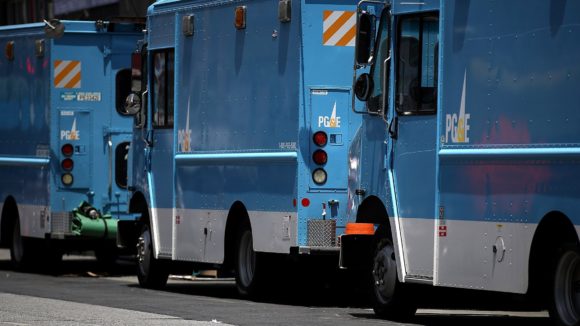Bankrupt utility giant PG&E Corp. owes a lot of money to a lot of businesses. A tree-trimming service. A California car dealership. A laundromat. Construction contractors galore.
Now, hedge funds including Olympus Peak Asset Management LP and Whitebox Advisors LLC are buying up claims vendors have filed against PG&E, aiming to cash in.
In many cases, vendors are recouping around 90 cents on every dollar PG&E owes them. But they’re paid quickly, without having to wait for the bankruptcy process to wrap up. The hedge funds, which can afford to wait, profit on the difference between the amount they pay the vendors and the money they will eventually get from the utility.
“Just imagine if you’re running a construction business and PG&E’s your largest customer, and you’ve got $500,000 in receivables you’re counting on,” said Vladimir Jelisavcic, manager of Cherokee Acquisition, which buys claims in bankruptcy and class action cases. “Selling a bankruptcy claim is a much faster and easier way to get cash than going to a lender.”
Already vendors have sold off claims against PG&E worth a total of about $470 million. The flurry of transactions illustrate just how far its bankruptcy — the largest utility restructuring in U.S. history — has rippled beyond California. The company, whose service territory covers more than 40% of the state, filed for Chapter 11 in January facing an estimated $30 billion in liabilities from a string of deadly wildfires that, in some cases, were blamed on its equipment. PG&E listed a total of $51.7 billion in debt.
325 Claims
As of Monday, about 325 PG&E claim sales had been recorded with the bankruptcy court. Whitebox bought more than 100, and Olympus Peak scooped up 25. The hedge funds declined to comment.
The volume of trading surrounding PG&E has been higher than usual for a corporate bankruptcy, probably because PG&E’s claims are fetching relatively high prices, Jelisavcic said. During the bankruptcy of Sears Holding Corp., for example, vendors selling received 55 to 70 cents on the dollar, and a total of the $65.1 million of Sears claims changed hands.
While a few of the PG&E claims sold top $10 million, most are far smaller. More than two-thirds seek less than $500,000. The claimants tend to be small businesses that provided services to PG&E, including electrical contractors, a shuttle bus operator, fencing companies, engineering consultants and suppliers of traffic and construction signs.
Aside from getting some of their cash faster, selling claims allows contractors to avoid the complications of pursuing the debt through bankruptcy, or hiring lawyers to do it for them. “Generally, it’s to avoid a lot of those uncertainties down the road,” said Negisa Balluku, a bankruptcy litigation analyst with Bloomberg Intelligence.
Online Market
Cherokee has even set up a website, Claims Market, to ease the process. It lets potential sellers post claims and solicit offers. PG&E claims on the site are fetching about 92 cents on the dollar, Jelisavcic said.
Most of the deals, however, are one-on-one private transactions. The buyers are mostly hedge funds that look for straightforward claims backed by invoices and other documentation, avoiding more nuanced suits such as homeowners suing over damaged houses.
Was this article valuable?
Here are more articles you may enjoy.


 Brazil Sues EV Giant BYD Over ‘Slavery’ Conditions at Plant
Brazil Sues EV Giant BYD Over ‘Slavery’ Conditions at Plant  Will Workers’ Comp Benefit from ‘Most-Favored-Nation’ Drug Pricing?
Will Workers’ Comp Benefit from ‘Most-Favored-Nation’ Drug Pricing?  Plane Crashes into San Diego Neighborhood, Setting Homes And Vehicles on Fire
Plane Crashes into San Diego Neighborhood, Setting Homes And Vehicles on Fire  Cars Are Getting Smarter. Why It Matters for Claims Professionals
Cars Are Getting Smarter. Why It Matters for Claims Professionals 